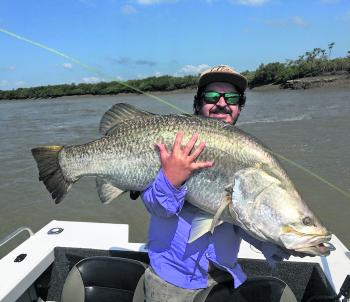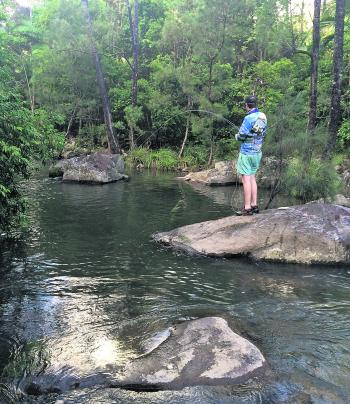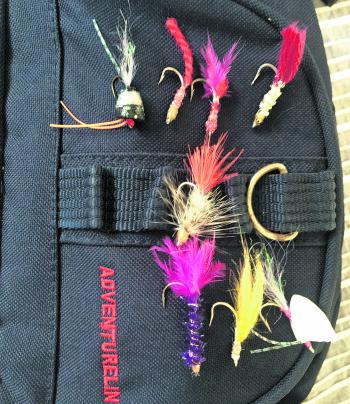What a start to the barra season on 1 Feb! Unfortunately for Mackay anglers it meant flooded creeks, heaps of dirty fresh water and low water temperatures, so opening day was not great. After getting around 600mm of rain in January no one was all that surprised.
Week two though was much better. We had only a few scattered showers and some minor storm activity giving the creeks a chance to clear up and the prawns to be in abundance. Prawns aplenty equal barra on the chew and that is exactly what happened.
The creeks in the net free zone around Seaforth copped plenty of attention and by all accounts the barra were co-operative for the most part. Live prawns were the bait of choice and a few on a 7/0 hook will soon attract attention if there’s a barra in the vicinity. Live mullet are always good bait but when the prawns are prolific then ‘match the hatch.’ Just remember, a single prawn in possibly hundreds won’t attract a lot of activity, but several together clicking and flicking will ring the dinner bell loud and clear!
Barra will continue to be the focus for many anglers during March, traditionally one of our wetter months, so it will be interesting to see what is in store for us. Having plenty of fresh water and prawns around also has a great side benefit of good numbers of king threadfin in all our creek systems.
There’s been plenty written about chasing barra and our creeks are similar to most although our big tide variations can cause some problems. The old saying ‘no run, no fun’ also applies to barra. Any rock bar or isolated rock in a creek is worth checking out and drifting a couple of prawns down current to the rocks will soon have any barra hanging around there responding. Don’t use wire trace and instead use 1m or so of 30kg mono or fluorocarbon leader that will let your live baits be presented more naturally.
Barra will also hang on individual mangroves on mud flats, as that is where the bait will be when the tide rises. Be there too and your chances of a barra will be increased - don’t be put off by the shallow water. Approaching with an electric motor is the way to go and making longer casts will lessen the chances of spooking the school of fish, as barra happily stay in small schools.
To score a saltwater barra during March try the local creeks like Reliance, Constant, Victor, Murray and Blackrock to the north. They are the main creeks but all have smaller creeks and side gullies that are worth checking out. In fact, any junction is worth putting in the time, especially on a run out tide.
If you’re heading south of Mackay, check out Bakers, Sandy, Alligator and Rocky Dam creeks as well as Sarina Inlet and the creeks in the Cape Palmerston area. Having a boat is a distinct advantage when fishing for barra in our creeks as it gives more opportunities to find the fish.
Mackay’s Pioneer River is also a reliable barra producer with many decent-size fish caught wthin the city reaches. The Pioneer is a beautiful bluewater system and popular spots include the road bridges and rocks near the highway. Upstream barra can be caught around the hospital and the trainer walls and right up to the freshwater near Dumbleton Weir. Live mullet and whiting are the most popular baits and soft vibes and paddle-tails are good lure choices.
The king threadfin seem to prefer the muddier stretches of the creeks and respond well to live prawns and bunches of yabbies. For the lure angler, threadies can be very frustrating when they are fixated on very small jelly prawns. Check out the Fuze 55mm scented prawns in the clear colour as they are a pretty good option. Rig with a small, strong hook and tiny sinker about 500mm above the prawn. That way the lure will float up in a lifelike way. They can be fished with a conventional jighead, but keep the weight right down so the prawn can be cast and retrieved just like the real thing. Kings will often be found in water that barely covers them so don’t neglect the waters close in to the banks.
The strong run of mangrove jack and their cousins the golden snapper (fingermark) has continued into February but I expect this will start to taper off during March. Good numbers have been caught in the creeks and around the headlands and islands, but neither species particularly likes an influx of freshwater so keep an eye on the rainfall figures if looking to chase either of them.
The usual estuary/creek species are around. The freshwater can put them off the chew. Whiting, flathead, bream and grunter are all on the prowl and many of the local young anglers are taking to chasing whiting with clear poppers over in Bassett Basin to the north of the Pioneer. Beautiful country with clear water and extensive sand flats draining out of the mangrove systems make this spot ideal to chase them.
As expected, the offshore scene has been very disrupted with dirty water around the spots closer in and this will likely continue through March depending on the rainfall. Further offshore there have been good catches of reds coming from the shipping channel with some nice trout around the Goldsmith group of islands and Stevens Reef but a fair size boat is needed with the capability of doing 200km round trips as a minimum.
The freshwater scene has been up and down and with the influx of freshwater all three dams are at capacity or very close to it. This means the fish spread out and are harder to locate. This applies to both sooties and barra.
Kinchant has seen 1m+ plus fish on the go around the full moon on both live baits and lures. Bony bream are the live bait of choice and they can be trapped. I have noticed some people using cast nets to get live bony bream. Please note, this is a breach of the regulations.
Big 150mm paddle-tails are accounting for plenty of barra in Kinchant and Teemburra dams as well as the usual mix of hardbody lures and surface offerings. If using surface lures remember to ‘perfect the pause’ as this seems to drive barra particularly nuts. I generally count to 20 before moving the surface lure, move it a short distance and then let it sit while counting to 20 again. This technique builds the suspense and the barra really seem to respond.
MAFSA is working to top up each of the three dams with barra fingerlings with 3,500 recently released into Eungella Dam and more on order for Kinchant and Teemburra. This summer MAFSA has also purchased barra in larger sizes, but fewer numbers, and will vary stocking sizes according to needs each year.
On the sooty front the huge news is the successful spawning at MAFSA’s hatchery. As at February, Kieron Galletly and his hatchery crew have approximately 300,000 babies to look after. They are about three weeks old and have formed swim bladders, so with a bit of luck and barring a disaster, most of them should grow to the release size of 50-70 mm. Most of these are destined for stocking into Eungella as there has been minimal spawning for the last few years in Broken River above the dam. Some will be kept in the hatchery to be released at the 12th Maverick Equipment Hire World Sooty Championship event on 29-30th April at Eungella Dam. Online nominations for the Championship will open mid to late February, so keep an eye on MAFSA’s Facebook page. Traditionally the fingerlings are released as part of the event and all the little (and not so little) kids get a big kick out of letting them go. The current fingerlings will give Eungella a big boost in sooty numbers and when coupled with a reasonable natural recruitment will help ensure Eungella’s reputation as an outstanding sooty grunter fishery is maintained.
March anglers can look forward to many options around the district from sooties at Eungella to trout and reddies out on the reef. Come up and join us in paradise.
Reads: 1412
We’ve had a fantastic start to the barra season this year.

Whopper barra are a real treat for anglers and they can be strong fighters too.

Barra will also hang on individual mangroves on mud flats, as that is where the bait will be as the tide rises. Be there too and your chances of a barra will be increased.

A selection of flies to cover all the bases for chasing sooty grunter this month.




